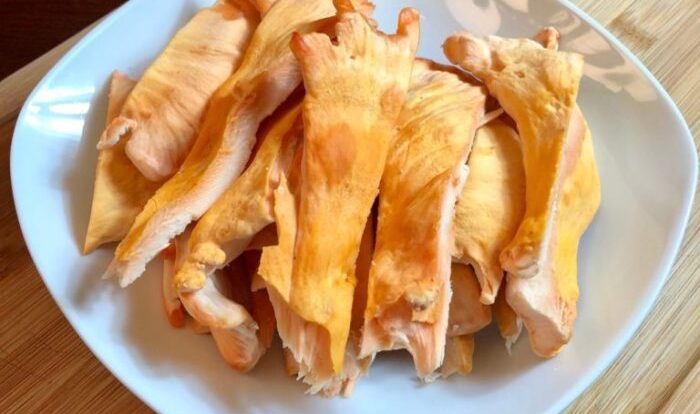
Chicken of the woods recipe is a culinary adventure that takes you deep into the forest’s hidden treasures. This vibrant mushroom boasts a unique flavor and texture, making it a versatile ingredient for a wide range of dishes. Whether you’re a seasoned forager or a curious cook, this guide will provide you with everything you need to know about chicken of the woods, from identification and foraging to cooking and preservation.
As we delve into the world of chicken of the woods, we’ll explore its nutritional benefits, culinary applications, and the fascinating process of cultivating and preserving this forest delicacy.
Recipe Variations

Chicken of the Woods is a versatile mushroom that can be prepared in various ways. Each cooking method imparts unique flavors and textures to the dish.
The following table compares different Chicken of the Woods recipes based on ingredients, cooking time, and difficulty level:
| Recipe | Ingredients | Cooking Time | Difficulty Level |
|---|---|---|---|
| Pan-Fried Chicken of the Woods | Chicken of the Woods, butter, salt, pepper | 15-20 minutes | Easy |
| Roasted Chicken of the Woods | Chicken of the Woods, olive oil, salt, pepper, herbs | 30-45 minutes | Easy |
| Sautéed Chicken of the Woods | Chicken of the Woods, butter, garlic, onion, herbs | 15-20 minutes | Easy |
| Chicken of the Woods Soup | Chicken of the Woods, vegetable broth, onions, carrots, celery | 45-60 minutes | Moderate |
| Chicken of the Woods Risotto | Chicken of the Woods, arborio rice, white wine, chicken broth, Parmesan cheese | 60-75 minutes | Moderate |
Pan-Fried Chicken of the Woods
Pan-frying Chicken of the Woods is a quick and easy way to enjoy its savory flavor. The mushrooms are simply sautéed in butter with salt and pepper until golden brown.
Roasted Chicken of the Woods
Roasting Chicken of the Woods brings out its earthy notes. The mushrooms are tossed in olive oil, salt, pepper, and herbs before being roasted in the oven until tender.
Sautéed Chicken of the Woods
Sautéing Chicken of the Woods with butter, garlic, and onions creates a flavorful and aromatic dish. The mushrooms are cooked until soft and caramelized.
Chicken of the Woods Soup
Chicken of the Woods soup is a hearty and comforting dish. The mushrooms are simmered in vegetable broth with onions, carrots, and celery until tender.
Chicken of the Woods Risotto
Chicken of the Woods risotto is a creamy and indulgent dish. The mushrooms are sautéed with arborio rice and white wine before being simmered in chicken broth until the rice is tender and creamy.
Nutritional Benefits
Chicken of the Woods is a nutritional powerhouse, offering a wealth of essential vitamins, minerals, and antioxidants. It is an excellent source of dietary fiber, which is crucial for digestive health and satiety. Furthermore, it is low in calories and fat, making it a guilt-free addition to a healthy diet.
Vitamin and Mineral Content
Chicken of the Woods is particularly rich in vitamins B, C, and D. Vitamin B complex plays a vital role in energy metabolism, nerve function, and cell growth. Vitamin C is a potent antioxidant that strengthens the immune system and protects against oxidative damage.
Vitamin D, essential for bone health, is often lacking in the modern diet, and Chicken of the Woods provides a natural source of this essential nutrient.
| Nutrient | Amount per 100g |
|---|---|
| Vitamin B1 (Thiamin) | 0.08mg |
| Vitamin B2 (Riboflavin) | 0.16mg |
| Vitamin B3 (Niacin) | 2.0mg |
| Vitamin B5 (Pantothenic Acid) | 0.2mg |
| Vitamin B6 (Pyridoxine) | 0.04mg |
| Vitamin C (Ascorbic Acid) | 15mg |
| Vitamin D (Ergocalciferol) | 1.2mcg |
| Potassium | 250mg |
| Phosphorus | 100mg |
| Magnesium | 20mg |
| Iron | 2mg |
Antioxidant Content
Chicken of the Woods contains a diverse range of antioxidants, including ergothioneine, phenolic acids, and flavonoids. These compounds protect cells from damage caused by free radicals, which are unstable molecules that can contribute to chronic diseases such as cancer and heart disease.
Ergothioneine, a unique antioxidant found in high concentrations in Chicken of the Woods, has been shown to promote longevity and protect against neurodegenerative disorders.
Potential Health Benefits
The nutritional value of Chicken of the Woods translates into several potential health benefits. The high fiber content promotes digestive health, while the antioxidants protect against oxidative damage. Studies have also shown that Chicken of the Woods may have anti-inflammatory, anti-tumor, and immune-boosting properties.
Culinary Applications

Chicken of the Woods is a versatile culinary delight that can be incorporated into a wide range of dishes. Its meaty texture and savory flavor make it a perfect substitute for chicken or other meats.
The versatility of Chicken of the Woods extends beyond its texture, as it pairs well with various cuisines and flavors. From hearty soups and stews to flavorful stir-fries and pasta dishes, Chicken of the Woods adds a unique depth of flavor to any meal.
If you’re craving a unique and flavorful culinary experience, look no further than the chicken of the woods recipe . This wild mushroom delicacy boasts a tender texture and savory taste that will tantalize your palate. Whether you’re a seasoned chef or a novice cook, this recipe is easy to follow and will yield a dish that’s sure to impress your family and friends.
Cooking Methods
- Sautéing:Sautéed Chicken of the Woods is a quick and easy way to enjoy its savory flavor. Simply heat some oil in a pan, add the mushroom, and cook until browned and tender.
- Roasting:Roasting Chicken of the Woods intensifies its flavor and creates a crispy exterior. Preheat your oven to 400°F (200°C) and roast the mushroom for 15-20 minutes, or until golden brown.
- Grilling:Grilling Chicken of the Woods gives it a smoky flavor. Brush the mushroom with oil and grill over medium heat for 5-7 minutes per side, or until tender.
- Frying:Frying Chicken of the Woods creates a crispy coating and a tender interior. Dip the mushroom in batter and fry in hot oil until golden brown.
Recipe Ideas
- Chicken of the Woods Alfredo:Sauté Chicken of the Woods and add it to a creamy Alfredo sauce served over pasta.
- Chicken of the Woods Stir-Fry:Stir-fry Chicken of the Woods with your favorite vegetables and a savory sauce.
- Chicken of the Woods Tacos:Sauté or roast Chicken of the Woods and serve it in tacos with your favorite toppings.
- Chicken of the Woods Soup:Add sautéed or roasted Chicken of the Woods to a hearty soup for extra flavor and texture.
Foraging and Identification
Chicken of the Woods, known for its bright orange-red coloration, is a sought-after mushroom with a unique flavor profile. To ensure a safe and successful foraging experience, proper identification is crucial.
This edible mushroom grows in clusters on the sides of dead or dying hardwood trees, particularly oak. Its shelf-like structure, with overlapping layers, resembles a chicken’s ruff, hence its name.
Identification Tips
- Color:The vibrant orange-red to yellow-orange color is a distinctive characteristic of Chicken of the Woods.
- Texture:The mushroom has a firm, meaty texture, similar to chicken flesh.
- Spore Color:The spores are white to cream-colored, and they are produced on the underside of the mushroom.
- Habitat:Chicken of the Woods is typically found growing on hardwood trees, especially oak.
Importance of Proper Identification
It is crucial to correctly identify Chicken of the Woods to avoid toxic lookalikes, such as the False Chicken of the Woods ( Laetiporus sulphureus), which is poisonous. The False Chicken of the Woods has a brighter orange color and smaller pores on the underside.
Cultivation and Preservation: Chicken Of The Woods Recipe

Chicken of the Woods is a delicious and nutritious mushroom that can be cultivated at home. The following guide will provide you with the steps on how to grow and preserve Chicken of the Woods.
Cultivation, Chicken of the woods recipe
Chicken of the Woods can be cultivated on logs or in sawdust. To cultivate on logs, you will need to find logs that are fresh and free of disease. Drill holes in the logs and insert the mushroom spawn. The logs should be placed in a shady spot and kept moist.
The mushrooms will begin to grow in 6-12 months.
To cultivate in sawdust, you will need to mix the spawn with sawdust and place it in a container. The container should be placed in a warm, dark place. The mushrooms will begin to grow in 2-3 months.
Preservation
Chicken of the Woods can be preserved by drying, freezing, or canning. To dry the mushrooms, slice them thinly and place them on a drying rack. The mushrooms should be dried in a warm, dry place until they are completely dry.
For those who prefer a more detailed guide, check out the chicken of the woods recipe available online. This comprehensive recipe provides step-by-step instructions, ensuring that even beginners can create a mouthwatering meal. From foraging tips to cooking techniques, this recipe has everything you need to prepare this culinary delight with confidence.
To freeze the mushrooms, slice them thinly and place them in a freezer-safe bag. The mushrooms can be frozen for up to 6 months. To can the mushrooms, follow the directions on the canning jar.
Ultimate Conclusion
Chicken of the woods recipe is a testament to nature’s culinary wonders. Its versatility, nutritional value, and ease of cultivation make it a valuable addition to any kitchen. Whether you’re sautéing it, grilling it, or adding it to a hearty soup, this mushroom is sure to impress your taste buds and leave you craving more.
FAQ Corner
What are the different cooking methods for chicken of the woods?
Chicken of the woods can be cooked in various ways, including sautéing, grilling, roasting, and frying. Each method yields a unique flavor and texture.
How do I identify chicken of the woods safely?
Chicken of the woods has distinct characteristics, such as its bright orange color and fan-shaped structure. It’s important to consult a field guide or consult with an experienced forager to avoid toxic lookalikes.
Can I grow chicken of the woods at home?
Yes, chicken of the woods can be cultivated on logs or sawdust. It requires a specific environment and careful maintenance, but it’s a rewarding experience for mushroom enthusiasts.